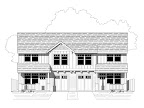Last post we discussed some interesting ways to increase the R-value of your walls while still maintaining normal and acceptable building practices. But let's say you want to take it a step further. Welcome the Passive House, a remarkable building process started in Germany and quickly becoming a popular method of building homes. Passive houses require no heating source but are generally required to have one per code.
"Wait, no heating source? No furnace, no baseboard heaters, no heat pump, no radiators?" Yup. I mean, nope, none of that. The homes are built so tight and insulated so well that they get heated every time you use a hair dryer or brew coffee. In fact you could keep the home heated all winter with a few well placed candles.
"But if the house is built tight and you're burning candles, won't you die of carbon monoxide inhalation? Shouldn't the house breathe?" Oh for the love of Pete, if your house 'breathed' you would be making monay selling tickets to an authentic haunted house. Houses don't need to breathe. The occupants inside need to breathe and yes you need to cycle fresh air through.
Performance issues first. R-values need to be 44 or better. This does not mean using R-44 insulation. This means the average value of your whole wall, including energy sucking R-3 windows, needs to be accounted for. Floors and ceilings need to achieve the same values. Currently these values are in the R-10 range for walls (using R-21 insulation), and R-30 for floors and ceilings assuming no penetrations. So the solution for floors and ceilings is simple, increase the value to R-49 in both and call it good. The walls are a little more difficult. How would you achieve an R-50 wall? One method is to use 9.5" I-joists for studs and fill the cavities with either spray foam or high-density blow-in. This gets you to R-38, and then add 3" of EPS rigid foam board to the outside. Typical windows are as good as R-3 (U=0.32), but R-7 (U=0.14) windows can be used.
Typical houses leak at a rate of 10 or so air changes per hour when you suck out 50 CFM of air. An Energy Star home cannot exceed 7 and 2 or 3 is generally considered darned good. But the Passive House must not exceed 0.6 ACH at CFM50.
"Oh the cost! This would be a fortune!". How much do you think it really is? Since R-5 windows are about the limit available in the U.S., you are looking at roughly an $8000 increase for a modest 2000sf home (foam is cheap). Not terrible, but here's the kicker. You can skip the HVAC system, so there's a $4000 savings. Instead you'll install a small HRV system to provide fresh air to the home without it adversely affecting temperature. Add about $2000. You'll also want to provide a couple of small cadet heaters so add another $1000. So you're in it for $7000 extra. But when you sell the house, market it well and you'll gain an extra $20,000 over similar homes. Why? Because the heating/cooling bills will be reduced from $200/mo to less than $50/mo. The extra $20k will finance at $120/mo. Math says that your buyers will save a few bucks a month or break even. That assumes that energy costs will stay stable. If you believe this, I've got a barn to sell you. So consider that this becomes a hedge against future energy costs and your buyer breaks even and gets a more comfortable home.
If you'd like your next house to be aggresively passive, we would be happy to detail it for you.
Tuesday, February 10, 2009
Subscribe to:
Post Comments (Atom)






No comments:
Post a Comment